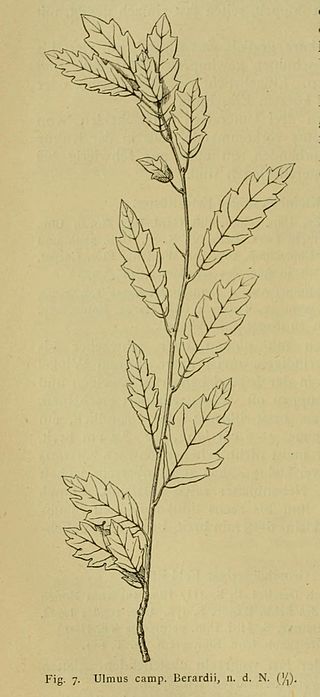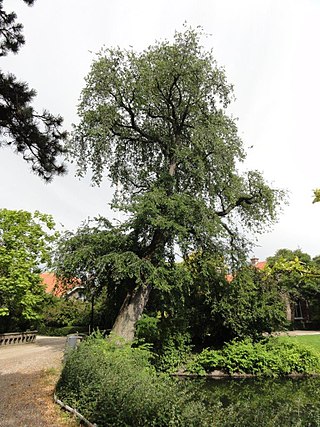
Crataegus, commonly called hawthorn, quickthorn, thornapple, May-tree, whitethorn, Mayflower, or hawberry, is a genus of several hundred species of shrubs and trees in the family Rosaceae, native to temperate regions of the Northern Hemisphere in Europe, Asia, North Africa, and North America. The name "hawthorn" was originally applied to the species native to northern Europe, especially the common hawthorn C. monogyna, and the unmodified name is often so used in Britain and Ireland. The name is now also applied to the entire genus and to the related Asian genus Rhaphiolepis.

Pelargonium is a genus of flowering plants that includes about 280 species of perennials, succulents, and shrubs, commonly called geraniums, pelargoniums, or storksbills. Geranium is also the botanical name and common name of a separate genus of related plants, also known as cranesbills. Both genera belong to the family Geraniaceae. Carl Linnaeus originally included all the species in one genus, Geranium, and they were later separated into two genera by Charles Louis L'Héritier de Brutelle in 1789.

Crataegus monogyna, known as common hawthorn, one-seed hawthorn, or single-seeded hawthorn, is a species of flowering plant in the rose family Rosaceae. It is native to Europe, northwestern Africa, and West Asia, but has been introduced in many other parts of the world.

Crataegus laevigata, known as the Midland hawthorn, English hawthorn, woodland hawthorn, or mayflower, is a species of hawthorn native to western and central Europe, from Great Britain and Spain east to the Czech Republic and Hungary. It is also present in North Africa. The species name is sometimes spelt C. levigata, but the original orthography is C. lævigata.

Karpatiosorbus latifolia is a species of whitebeam that is endemic to the area around Fontainebleau, south of Paris in France, where it has been known since the early eighteenth century.

The hybrid cultivar Ulmus × hollandica 'Cicestria', commonly known as the 'Chichester Elm', was cloned at the beginning of the 18th century from a tree growing at Chichester Hall, Rawreth, near Danbury, Essex, England, then the home of Thomas Holt White FRS, brother of the naturalist Gilbert White. The tree was first recorded by country parson and botanist Adam Buddle in south-east Essex in 1711, and appeared as U. cicestria in an 1801 catalogue. 'Cicestria' is the original Ulmus × hollandica 'Vegeta', but suffered confusion with the later Huntingdon Elm cultivar by John Claudius Loudon who, without consulting Lindley, accorded the epithet 'Vegeta' to Huntingdon Elm in 1838, as he found the two indistinguishable. J. E. Little in The Journal of Botany (1923) agreed that Buddle's leaves-specimen of Chichester Elm in the Sloane Herbarium seemed to be the same cultivar as Huntingdon Elm: "If so, this elm [Chichester] was in existence and mature some years before the reputed raising of the Huntingdon Elm by Wood of Huntingdon 'about 1746'."

The Field Elm cultivar Ulmus minor 'Atinia Variegata', the Variegated-leaved common English Elm, formerly known as U. procera 'Argenteo-Variegata' and described by Weston (1770) as U. campestris argenteo-variegata, is believed to have originated in England in the seventeenth century and to have been cultivated since the eighteenth. The Oxford botanist Robert Plot mentioned in a 1677 Flora a variegated elm in Dorset, where English Elm is the common field elm. Elwes and Henry (1913) had no doubt that the cultivar was of English origin, "as it agrees with the English Elm in all its essential characters". At the Dominion Arboretum, Ottawa, the tree was listed as U. procera 'Marginata', as the variegation is sometimes most obvious on leaf-margins.

The Field Elm cultivar Ulmus minor 'Viminalis Aurea', probably a "golden" form of Ulmus minor 'Viminalis', was raised before 1866 by Egide Rosseels of Louvain, who was known to have supplied 'Viminalis'.

The elm cultivar Ulmus 'Purpurea', the purple-leaved elm, was listed and described as Ulmus Stricta Purpurea, the 'Upright Purpled-leaved Elm', by John Frederick Wood, F.H.S., in The Midland Florist and Suburban Horticulturist (1851), as Ulmus purpureaHort. by Wesmael (1863), and as Ulmus campestris var. purpurea, syn. Ulmus purpureaHort. by Petzold and Kirchner in Arboretum Muscaviense (1864). Koch's description followed (1872), the various descriptions appearing to tally. Henry (1913) noted that the Ulmus campestris var. purpureaPetz. & Kirchn. grown at Kew as U. montana var. purpurea was "probably of hybrid origin", Ulmus montana being used at the time both for wych elm cultivars and for some of the U. × hollandica group. His description of Kew's U. montana var. purpurea matches that of the commonly-planted 'Purpurea' of the 20th century. His discussion of it (1913) under U. campestris, however, his name for English Elm, may be the reason why 'Purpurea' is sometimes erroneously called U. procera 'Purpurea' (as in USA and Sweden.

The elm cultivar Ulmus 'Crispa' [:'curled', the leaf margin], sometimes known as the Fernleaf Elm, arose before 1800 and was first listed by Willdenow as U. crispa (1809). Audibert listed an U. campestrisLinn. 'Crispa', orme à feuilles crépues [:'frizzy-leaved elm'], in 1817, and an Ulmus urticaefolia [:'nettle-leaved elm'] in 1832; the latter is usually taken to be a synonym. Loudon considered the tree a variety of U. montana (1838). In the 19th century, Ulmus × hollandica cultivars, as well as those of Wych Elm, were often grouped under Ulmus montana. Elwes and Henry (1913) listed 'Crispa' as a form of wych elm, but made no mention of the non-wych samara.

The elm cultivar Ulmus 'Berardii', Berard's Elm, was raised in 1865, as Ulmus Berardi, from seeds collected from large specimens of "common elm" growing on the ramparts at Metz, by an employee of the Simon-Louis nursery named Bérard. Carrière (1887), the Späth nursery of Berlin and the Van Houtte nursery of Gentbrugge regarded it as form of a Field Elm, listing it as U. campestris Berardii, the name used by Henry. Cheal's nursery of Crawley distributed it as Ulmus nitens [:Ulmus minor] 'Berardii'. Smith's of Worcester preferred the original, non-specific name, Ulmus 'Berardii'.

The putative Wych Elm cultivar Ulmus glabra 'Latifolia' was identified in Audibert's Tonelle (1817) as U. campestrisLinn. [ = U. glabraHuds.] latifolia. The tree is reputed to have originated circa 1750 in or around Mechelen, and to have been widely planted throughout Belgium. A 1912 herbarium specimen from Oudenbosch, however, shows a hybrid leaf labelled Ulmus hollandica latifolia.

The Field Elm cultivar Ulmus minor 'Pendula' was said to have been raised in Belgium in 1863. It was listed as Ulmus sativa pendula by C. de Vos in 1887, and by Boom in 1959 as a cultivar.
Ulmus ellipticaKoch is a disputed species of elm, native to the Caucasus, where Koch reported that it formed extensive woods, and ranging north to southern Ukraine. The tree is said to be closely related to U. glabra, but to resemble U. rubra in its samara. Many authorities consider U. ellipticaKoch just a regional form of U. glabra, though Henry, Bean and Krüssman list the Caucasus tree as a species in its own right. U. ellipticaKoch is distinguished from U. scabraMill. [:U. glabra] in some Armenian and Russian plant lists.

Crataegus mexicana is a species of hawthorn known by the common names tejocote, manzanita, tejocotera and Mexican hawthorn. It is native to the mountains of Mexico and parts of Guatemala, and has been introduced in the Andes. The fruit of this species is one of the most useful among hawthorns.
Stigmella oxyacanthella is a moth of the family Nepticulidae, found in Europe and North America. The larvae are leaf miners feeding inside the leaves of trees and shrubs, such as hawthorn, apple and pear.

The wych elm cultivar Ulmus glabraHuds. 'Superba', Blandford Elm, with unusually large leaves, was raised by Gill's of Blandford Forum, Dorset, in the early 1840s as Ulmus montana superba and was quickly distributed to other UK nurseries. It was confirmed as a form of wych, and first described, by Lindley in The Gardeners' Chronicle, 1845, later descriptions being added by Gill (1845) and Morren (1848), who called it U. montana var. superba. Morren had adopted the name 'Superba' from the Fulham nurseryman Osborne in 1844, who supplied him with the tree – presumably one of the nurseries supplied by Gill. Morren states that 'Superba', already in cultivation in England, was introduced to Belgium by Denis Henrard of Saint Walburge, Liège, that in 1848 it had been present in Belgium for only three years, and that this variety was the one described as 'Superba' by Osborne, whom Henrard had visited at his nursery in Fulham in September 1844. 'Blandford Elm', with leaves of the same dimensions, was soon for sale in the USA.

Crataegus persimilis is a species of hawthorn, known by the common names plumleaf hawthorn and broad-leaved cockspur thorn, native to southern Ontario, Canada, and the US states of New York, Pennsylvania, Ohio, Kentucky, West Virginia, and Virginia. It is widely cultivated, particularly in Europe, as an ornamental. Its sporadic distribution in its natural range and certain of its morphological characters leads authorities to consider it a probable naturally occurring hybrid, with its most likely parents being Crataegus succulenta and Crataegus crus-galli. It is a tetraploid. Some populations may be self-perpetuating. Its 'Prunifolia' cultivar has gained the Royal Horticultural Society's Award of Garden Merit, and is considered one of its top 5 trees for smaller gardens.

















